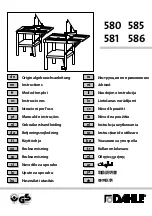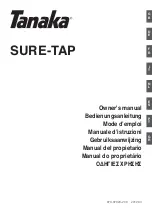
Safety instructions
English
10
4
Cutting procedures
a)
DANGER: Keep hands away from cutting
area and the blade. Keep your second hand on
auxiliary handle, or motor housing.
If both hands are
holding the saw, they cannot be cut by the blade.
b)
Do not reach underneath the workpiece.
The
guard cannot protect you from the blade below the
workpiece.
c)
Adjust the cutting depth to the thickness of the
workpiece.
Less than a full tooth of the blade teeth
should be visible below the workpiece.
d)
Never hold the workpiece in your hands or
across your leg while cutting. Secure the
workpiece to a stable platform.
It is important to
support the work properly to minimize body exposure,
blade binding, or loss of control.
e)
Hold the power tool by insulated gripping
surfaces, when performing an operation where the
cutting tool may contact hidden wiring or its own
cord.
Contact with a "live" wire will also make exposed
metal parts of the power tool "live" and could give the
operator an electric shock.
f)
When ripping, always use a rip fence or straight
edge guide.
This improves the accuracy of cut and
reduces the chance of blade binding.
g)
Always use blades with correct size and shape
(diamond versus round) of arbour holes.
Blades that
do not match the mounting hardware of the saw will run
off-centre, causing loss of control.
h)
Never use damaged or incorrect blade washers
or bolt.
The blade washers and bolt were specially
designed for your saw, for optimum performance and
safety of operation.
5 Lower guard function
a)
Check the lower guard for proper closing before
each use. Do not operate the saw if the lower guard
does not move freely and close instantly. Never
clamp or tie the lower guard into the open position.
If the saw is accidentally dropped, the lower guard may
be bent. Raise the lower guard with the retracting
handle and make sure it moves freely and does not
touch the blade or any other part, in all angles and
depths of cut.
b)
Check the operation of the lower guard spring. If
the guard and the spring are not operating
properly, they must be serviced before use.
Lower
guard may operate sluggishly due to damaged parts,
gummy deposits, or a build-up of debris.
c)
The lower guard may be retracted manually only
for special cuts such as "plunge cuts" and
"compound cuts". Raise the lower guard by the
retracting handle and as soon as the blade enters
the material, the lower guard must be released.
For
all other sawing, the lower guard should operate
automatically.
Содержание Pipecut 280 Pro Series
Страница 4: ...English 4 FIGURE A2...
Страница 17: ...Operation English 17 Saw has moved from left to right...








































